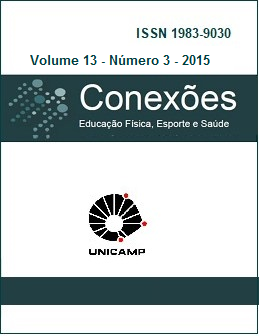Resumen
El presente estudio tuvo como objetivo describir los parámetros de tiempo y movimiento
en las luchas de artes marciales mixtas (MMA), y compararlos según el género. La muestra
consistió en 64 actuaciones (32 de cada género), y diferentes variables temporales fueron
analizadas. Para comparaciones fue utilizada analise de co-variancia. Se observó una
relación de esfuerzo alta:baja intensidad de 2:1 y las diferencias de género em la duración
total de baja intensidad de pie (04:19,7±03:19,5 min para los hombres y 06:55,6±04:47,7
min para las mujeres, p <0,05), de alta intensidad em suelo (01:14,6±01:16,4 para los
hombres y00:40,8±01:09,1 para las mujeres, p <0,05) y la frecuencia de los ataques, con
47 (±22,83) en los hombres y 21 (±15,11) en las mujeres, y los ataques a la cabeza con 31
(±18,51) para los hombres y 15 (±6,28) para las mujeres. Concluye que existen diferencias
en la temporalidad en combates de MMA segundo géneros, con las mujeres desarrollando
más tiempoen baja intensidad de pie, mas con menor tiempo para erfuerzos en alta
intensidad de pie y enelsuelo. Estos resultados contribuyen en la planificación de la
formación más específica para MMA.
Citas
PAIVA, L. Pronto pra guerra: preparação física para luta e superação. Manaus: OMP, 2009.
KIM, S. et al. An analysis of spectator motives in an individual combat sport: a study of mixed martial arts fans. Sport Marketing Quarterly, Morgantown, v. 17, n. 2, p. 109-119, 2008.
WERTHEIM, L. J. The new main event. Sports Illustrated, New York, v. 106, n. 22, p. 52-60, 2007.
BOUNTY, P. et al. Strength and conditioning considerations for mixed martial arts. Strength and Conditioning Journal, Colorado Springs, v. 33, n. 1, p. 56-67, 2011.
ULTIMATE FIGHTING CHAMPIONSHIP (UFC). Formas de vitória. Disponivel em: http://br.ufc.com/discover/sport/ways-to-win. Acesso em: 15 jun. 2014.
DEL VECCHIO F. B.; HIRATA, S.; FRANCHINI, E. A review of time-motion analysis and combat development in mixed martial arts matches at regional level tournaments. Perceptual and Motor Skills, Missoula, v. 112, n. 2, p. 1-10, 2011.
MIARKA, B. et al. A comparison of time-motion performance between age groups in judo matches. Journal of Sports Sciences, London, v. 30, n. 9, p. 899-905, 2012.
CALMET, M.; MIARKA, B.; FRANCHINI, E. Modeling of grasps in judo contests. International Journal of PerformanceAnalysis in Sport, Cardiff, v. 10, n. 3, p. 229–240, 2010.
GOROSTIAGA, E. M. Coste energético del combate de Judo. APUNTS Medicina de L’Esport, Barcelona, v. 25, n. 97, p. 135–139, 1988.
ARRIAZA, R. Karate. In: KORDI, R. et al. Combat sports medicine. London: Springer-Verlag; 2009, p. 287-298. Disponível em: http://books.google.es/books?id=Zwok7ECHn0wC&lpg=PR1&dq=Combat%20Sports%20Medicine&hl=es&pg=PR4#v=onepage&q&f=false. Acesso em: 15 jun. 2014.
BUSE, G. J.; SANTANA, J. C. Conditioning strategies for competitive kickboxing. Strength and Conditioning Journal, Colorado Springs, v. 30, n. 4, p. 42-48, 2008.
SILVA, J. J. R. et al. Time-motion analysis in combat sports. Journal of Human Sport e Exercise, Alicante, v. 6, n. 3, p. 490-496, 2011.
MIARKA et al. Técnica y táctica en judo: una revisión. Revista de Artes Marciales Asiáticas, León, v. 5, p. 91-112, 2010.
ANDREATO, L.V. et al. Physiological and technical-tactical analysis in brazilian jiu-jitsu competition. Asian Journal of Sports Medicine, Tehran, v. 4, n .2, p. 137-143, 2013.
DEL VECCHIO, F. B. et al. Análise morfo-funcional de praticantes de brazilian jiu-jitsu e estudo da temporalidade e da quantificação das ações motoras na modalidade. Movimento e Percepção, Espirito Santo do Pinhal, v. 7, n. 10, p. 263-281, 2007.
NILSSON, J. et al.Work-time profile, blood lactate concentration, and rating of perceived exertion in the 1998 Greco-Roman wrestling World Championship. Journal of Sports Sciences, London, v. 20, n. 11, p. 939-945, 2002.
BENEKE, R. et al. Energetics of karate kumite. European Journal of Applied Physiology, Heidelberg, v. 92, n. 5, p. 518-523, 2004.
HELLER, J. et al. Physiological profiles of male and female taekwondo (ITF) black belts. Journal of Sports Sciences, London, v. 16, n. 3, p. 243-249, 1998.
MATSUSHIGUE, K. A.; HARTMANN, K.; FRANCHINI, E. Taekwondo: physiological responses and match analysis. Journal of Strength and Conditioning Research, Colorado Springs, v. 23, n. 4, p. 1112-1117, 2009.
DEL VECCHIO F. B.; HIRATA S.; FRANCHINI, E. A review of time-motion analysis and combat development in mixed martial arts matches at regional level tournaments. Perceptual and Motor Skills, Missoula, v. 112, n. 2, p. 1-10, 2011.
ANDREATO, L. V.; PAIVA, L. Estrutura temporal de combates de mixed martial arts, 2010. Disponível em: http://www.def.uem.br/cipe2011/geraTrabalho.php?idt=203. Acesso em: 30 jun. 2014.
BLEACHER REPORT. the death of strikeforce: the oral history of the UFC's great alternative. Disponível em: http://bleacherreport.com/articles/1480248-the-death-ofstrikeforce-the-oral-history-of-the-ufcs-great-alternative-pt-2. Acesso em: 15 jun. 2014.
CABLE NEWS NETWORK (CNN). Rousey wins first UFC women's match. Disponível em: http://edition.cnn.com/2013/02/24/us/ufc-women-fight/. Acesso em: 15 jun. 2014.
THOMAZINI, S. O.; MORAES, C. E. A.; ALMEIDA, F. Q. Controle de si, dor e representação feminina entre lutadores(as) de mixed martial arts. Pensar a Prática, Goiânia, v.11, n. 3, p. 281-290, 2008.
THOMAS, J. R.; NELSON, J. K.; SILVERMAN, S. J. Métodos de pesquisa em atividade física. 6. ed. Porto Alegre: Artmed, 2012.
MIARKA, B. et al. Objectivity of FRAMI: software for judo match analysis. International Journal Performance Analysis Sport, Cardiff, v. 11, n. 2, p. 254–266, 2011.
CURRELL, K.; JEUKENDRUP, A. E. Validity, reliability and sensitivity of measures of sporting performance. Sports Medicine, London, v. 38, n. 4, p. 297-316, 2008.
FIELD, A. Discovering statistics using IBM SPSS statistics. Los Angeles: Sage, 2010.
SCHICK, M. G.; BROWN, L. E.; SCHICK, E. E. Strength and conditioning considerations for female mixed martial artists. Strength and Conditioning Journal, Colorado Springs, v. 1, n. 1, p. 66-75, 2012.
PANISSA, V.; MIARKA, B.; JULIO, U. F. Diferenças entre homens e mulheres nas respostas fisiológicas e no desempenho do esforço único e repetido. Revista Inova Saúde, Criciúma, v. 2, n. 1, p. 68-92, 2013.
O periódico Conexões: Educação Física, Esporte e Saúde utiliza a licença do Creative Commons (CC), preservando assim, a integridade dos artigos em ambiente de acesso aberto.


